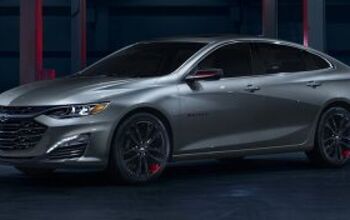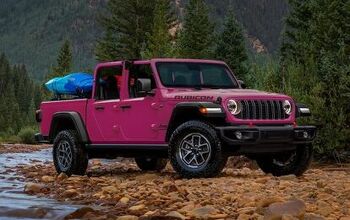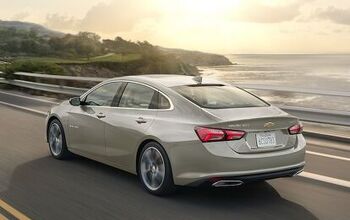EPA Ratings Reveal the Rest of the GM 2.7-liter Story

Last month, General Motors released EPA-estimated fuel economy figures for one of the new, turbocharged 2.7-liter inline-four’s applications: the two-wheel drive version of the 2019 Chevrolet Silverado and GMC Sierra pickups.
Despite boasting 310 horsepower and 348 lb-ft of torque, the engine’s combined estimated fuel economy of 21 miles per gallon left many wanting more. Now that we have EPA figures for the rest of the line, it’s no surprise to see that figure serve as an MPG high water mark.
(Kudos to the eagle-eyed Bozi Tatarevic, who noticed the new figures)
In two-wheel drive applications, the 2.7-liter, which comes standard on LT and RST trims, rates 20 mpg city, 23 mpg highway, and 21 mpg combined. That’s an average of 1 mpg more than the 4.3-liter V6 found in last year’s mainstream, lower-trim pickups, which made do with two fewer forwards gears (six, to the 2.7’s eight). Still, the new mill beats the old one by 25 hp and 43 lb-ft of torque.
Moving up to GM’s 5.3-liter V8, optional on both 2.7L trims, brings additional horsepower and torque, at the expense of two fewer MPGs in combined driving.
Luckily for The General, adding four-wheel drive to the 2.7-liter models doesn’t cause an embarrassing dip below 20 mpg. The EPA rates the 2.7L/4WD models at 20 mpg combined, 19 mpg city, and 22 mpg highway — a combined drop of 1 mpg compared to the 2WD model. Compared to 5.3L/4WD models, the four-cylinder beats it by 2 mpg when equipped with the same eight-speed tranny, or 3 mpg if the V8’s bolted to the low-rent six-speed.
The top-flight 6.2-liter V8, when equipped with four-wheel drive, also sees a 3 mpg difference between it and the 4WD 2.7L.
As we told you before, Ford and Ram’s base V6 engines offer a slight edge in fuel economy, though the 2.7L handily trounces the 3.3-liter Ford V6 in terms of power. The GM’s two main rivals also narrowly edge out the 2.7L’s tow rating of 7,200 pounds. Ford’s 3.3-liter tops out at 7,700 pounds, while the 3.6-liter Ram is rated for up to 7,730 lbs.
[Image: General Motors]

More by Steph Willems
Latest Car Reviews
Read moreLatest Product Reviews
Read moreRecent Comments
- Namesakeone If I were the parent of a teenage daughter, I would want her in an H1 Hummer. It would be big enough to protect her in a crash, too big for her to afford the fuel (and thus keep her home), big enough to intimidate her in a parallel-parking situation (and thus keep her home), and the transmission tunnel would prevent backseat sex.If I were the parent of a teenage son, I would want him to have, for his first wheeled transportation...a ride-on lawnmower. For obvious reasons.
- ToolGuy If I were a teen under the tutelage of one of the B&B, I think it would make perfect sense to jump straight into one of those "forever cars"... see then I could drive it forever and not have to worry about ever replacing it. This plan seems flawless, doesn't it?
- Rover Sig A short cab pickup truck, F150 or C/K-1500 or Ram, preferably a 6 cyl. These have no room for more than one or two passengers (USAA stats show biggest factor in teenage accidents is a vehicle full of kids) and no back seat (common sense tells you what back seats are used for). In a full-size pickup truck, the inevitable teenage accident is more survivable. Second choice would be an old full-size car, but these have all but disappeared from the used car lots. The "cute small car" is a death trap.
- W Conrad Sure every technology has some environmental impact, but those stuck in fossil fuel land are just not seeing the future of EV's makes sense. Rather than making EV's even better, these automakers are sticking with what they know. It will mean their end.
- Add Lightness A simple to fix, strong, 3 pedal car that has been tenderized on every corner.


































Comments
Join the conversation
I was looking forward to this truck. I figured a 4cylinder is plenty... but this fuel economy is atrocious. Its less than the F150, with 2 less cylinders. Its less than the Ridgeline, with 2 less cylinders. I was thinking more like 24-25 MPG? Than I'd be talking... but I guess thats more about weight and aerodynamics than powertrain.
Not impressed. I'm getting a real average of 20.5 mpg combined (mostly city) from my '18 F150 XLT 4X4 Supercab 2.7L Ecoboost. I'd bet if I had a 2.7L EB F150 4X2 regular cab I'd have no problem surpassing 24 combined.